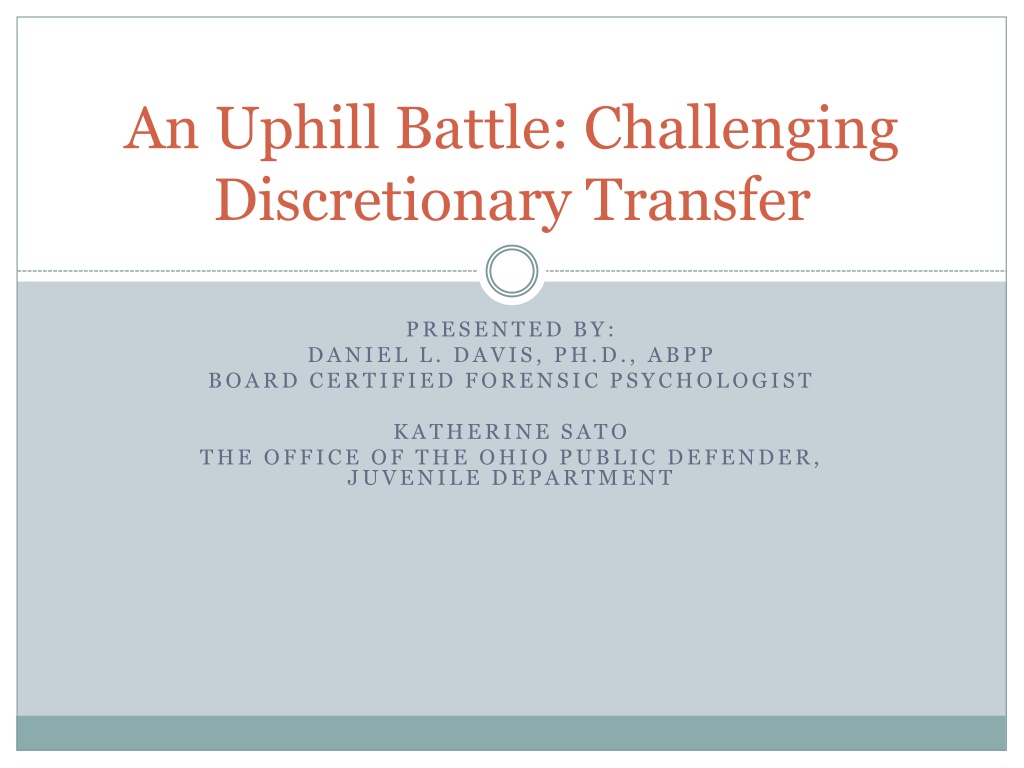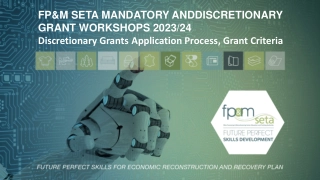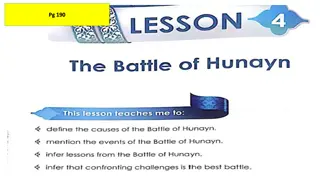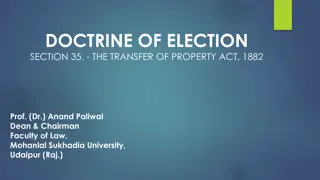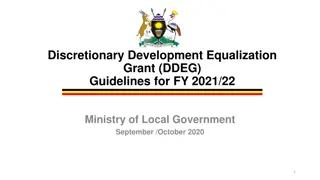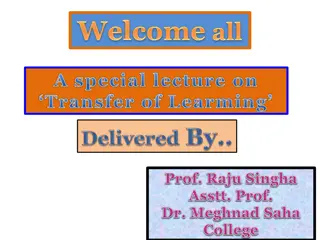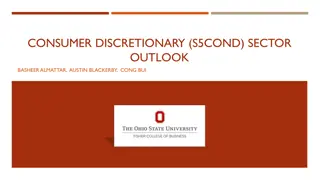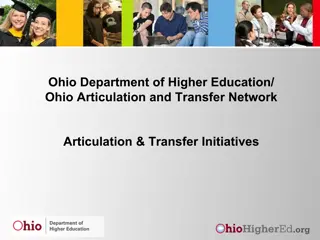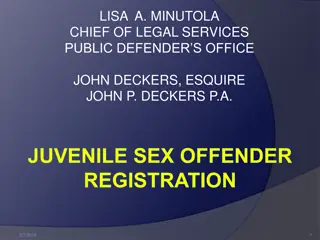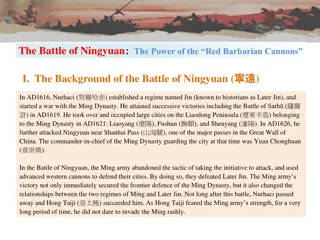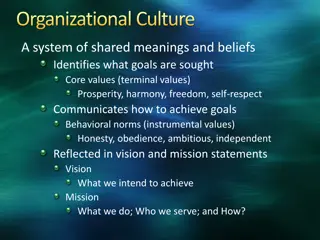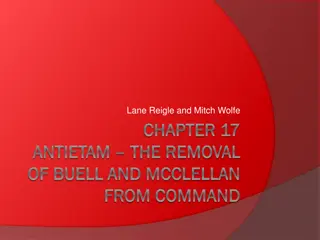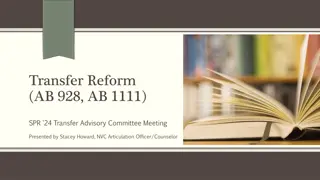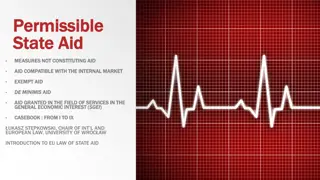An Uphill Battle: Challenging Discretionary Transfer
In the realm of juvenile justice, the process of discretionary transfer can be complex and demanding. Dr. Daniel L. Davis and Katherine Sato from the Office of the Ohio Public Defender delve into the intricacies involved in such transfers, including factors to be considered, evaluation of amenability, and the significance of expert testimony. The decision-making process for transferring juvenile cases to the adult system is meticulously outlined, highlighting the critical role of evidence and expert opinions in determining the course of action best suited for the child's rehabilitation and community safety.
Download Presentation

Please find below an Image/Link to download the presentation.
The content on the website is provided AS IS for your information and personal use only. It may not be sold, licensed, or shared on other websites without obtaining consent from the author. Download presentation by click this link. If you encounter any issues during the download, it is possible that the publisher has removed the file from their server.
E N D
Presentation Transcript
An Uphill Battle: Challenging Discretionary Transfer PRESENTED BY: DANIEL L. DAVIS, PH.D., ABPP BOARD CERTIFIED FORENSIC PSYCHOLOGIST KATHERINE SATO THE OFFICE OF THE OHIO PUBLIC DEFENDER, JUVENILE DEPARTMENT
The Plan for Our Session R.C. 2152.12 factors 1. 2. Records to collect and witnesses to interview 3. Retaining an expert 4. The amenability evaluation 5. Convincing the court
R.C. 2152.12(B) (B) Except as provided in division (A) of this section, after a complaint has been filed alleging that a child is a delinquent child for committing an act that would be a felony if committed by an adult, the juvenile court at a hearing may transfer the case if the court finds all of the following: (1) The child was fourteen years of age or older at the time of the act charged. (2) There is probable cause to believe that the child committed the act charged. (3) The child is not amenable to care or rehabilitation within the juvenile system, and the safety of the community may require that the child be subject to adult sanctions. In making its decision under this division, the court shall consider whether the applicable factors under division (D) of this section indicating that the case should be transferred outweigh the applicable factors under division (E) of this section indicating that the case should not be transferred. The record shall indicate the specific factors that were applicable and that the court weighed.
R.C. 2152.12(D) Factors in Favor of Transfer (D) In considering whether to transfer a child under division (B) of this section, the juvenile court shall consider the following relevant factors, and any other relevant factors, in favor of a transfer under that division: (1) The victim of the act charged suffered physical or psychological harm, or serious economic harm, as a result of the alleged act. (2) The physical or psychological harm suffered by the victim due to the alleged act of the child was exacerbated because of the physical or psychological vulnerability or the age of the victim. (3) The child's relationship with the victim facilitated the act charged. (4) The child allegedly committed the act charged for hire or as a part of a gang or other organized criminal activity. (5) The child had a firearm on or about the child's person or under the child's control at the time of the act charged, the act charged is not a violation of section 2923.12 of the Revised Code, and the child, during the commission of the act charged, allegedly used or displayed the firearm, brandished the firearm, or indicated that the child possessed a firearm. (6) At the time of the act charged, the child was awaiting adjudication or disposition as a delinquent child, was under a community control sanction, or was on parole for a prior delinquent child adjudication or conviction. (7) The results of any previous juvenile sanctions and programs indicate that rehabilitation of the child will not occur in the juvenile system. (8) The child is emotionally, physically, or psychologically mature enough for the transfer. (9) There is not sufficient time to rehabilitate the child within the juvenile system. Details of Offense Juvenile History Maturity Time for Rehab
R.C. 2152.12(E) Factors Against Transfer (E) In considering whether to transfer a child under division (B) of this section, the juvenile court shall consider the following relevant factors, and any other relevant factors, against a transfer under that division: (1) The victim induced or facilitated the act charged. (2) The child acted under provocation in allegedly committing the act charged. (3) The child was not the principal actor in the act charged, or, at the time of the act charged, the child was under the negative influence or coercion of another person. (4) The child did not cause physical harm to any person or property, or have reasonable cause to believe that harm of that nature would occur, in allegedly committing the act charged. (5) The child previously has not been adjudicated a delinquent child. (6) The child is not emotionally, physically, or psychologically mature enough for the transfer. (7) The child has a mental illness or intellectual disability. (8) There is sufficient time to rehabilitate the child within the juvenile system and the level of security available in the juvenile system provides a reasonable assurance of public safety. Details of Offense Juvenile History Maturity MI or ID Time for Rehab
Any other relevant factors Treatment options available in juvenile vs. adult facilities Recidivism rates for juvenile vs. adult incarceration Minimum/maximum sentence if retained vs. transferred Other factors specific to your client?
Identifying & Collecting Records What records do you want to review to prepare for your amenability/bindover/ transfer hearing?
Identifying & Collecting Records Juvenile court records (all prior cases) Detention center records Records from other residential/psychiatric facilities Counseling records School records Employment records Children services records* Parents records (arrests, criminal cases, divorce) Others?
Identifying & Interviewing Witnesses Who would you like to speak with when preparing for an amenability/bindover/ transfer hearing?
Identifying & Interviewing Witnesses Client Family Friends Teachers/coaches/guidance counselors Counselors/social workers Neighbors Girlfriends/boyfriends Detention center staff Employers Others?
Interviewing Witnesses Topics to Cover Pre-natal/developmental history Childhood Adolescence Family and social relationships Medical/mental health/ substance abuse history Education/ID/DD/ADHD/IEP Prior legal involvement Family background (generational patterns) Offense/stressors preceding offense Positive, productive aspects of client Prior placements (detention, psychiatric facility, DYS, etc.) Opportunities for rehabilitation Other topics?
Retaining an Expert When? Consulting vs. testifying expert Who pays for the report? Who sees the report? What qualifications are needed? Remember to review discipline history!
Convincing the Court 1. Link treatment needs with services available in juvenile system 2. SYO possibility 3. Weighing of factors 4. Findings required to transfer
Convincing the Court Link identified treatment needs with availability of treatment in the juvenile system. Ask expert to identify treatment needs Seek additional testimony (DYS, director of other juvenile facility) Identify ways in which an adult facility could not address your client s treatment needs. Any other relevant factor
Convincing the Court SYO is (almost) always a possibility. Carrot and Stick Theoretically, the threat of the imposition of an adult sentence encourages a juvenile s cooperation in his own rehabilitation, functioning as both carrot and stick. State v. D.H., 120 Ohio St.3d 540, 2009-Ohio-9, 910 N.E.2d 209, 18. When mandatory? Child 14 or 15 and adjudicated delinquent for aggravated murder or murder (or an attempt thereof). R.C. 2152.11(B)(1). Child 16 or 17 and adjudicated delinquent for F1 offense of violence and either the child used a firearm or was previously admitted to DYS for aggravated murder, murder, F1, F2, or F3 offense of violence. R.C. 2152.11(D)(1). When discretionary? Child 16 or 17 and adjudicated delinquent for F1 and R.C. 2152.11(D)(1) does not apply. R.C. 2152.11(D)(2)(a). Child 14 or 15 and adjudicated delinquent for F1. R.C. 2152.11(D)(2)(b).
Convincing the Court Weighing of factors in favor of and against transfer. Do not concede anything you don t have to. Require State to present evidence to prove factors in favor of transfer. Not simply a numbers game Not an even playing field Presumption of amenability In making its decision under this division, the court shall consider whether the applicable factors under division (D) of this section indicating that the case should be transferred outweigh the applicable factors under division (E) of this section indicating that the case should not be transferred. R.C. 2152.12(B)(3). Offense should not be super factor
Specific Findings Required Prior to Transfer State v. D.H., 2d Dist. Montgomery No. 26383, 2015-Ohio-3259 Summary: 17-year-old D.H. charged with two counts of robbery based on knockout game. Neither victim needed medical attention. D.H. admitted both incidents, but showed no remorse or concern for the victims. D.H. had no prior juvenile court history (other than a misdemeanor theft which was handled informally), but had been expelled from school for several incidents. The parties stipulated to the report from the court-ordered psychologist, but none of the supplemental reports reviewed by the psychologist were made part of the record or addressed by the Court during the hearing or in the entry relinquishing jurisdiction. The juvenile court relinquished jurisdiction after reciting the factors and indicating which factors weighed in favor of and against transfer.
Specific Findings Required Prior to Transfer The Court of Appeals found that the juvenile court s entry contained insufficient factual findings to identify how the court reached its conclusion that D.H. could not be rehabilitated in the juvenile system. Id. at 17. Cause remanded to the juvenile court for reconsideration of its decision to relinquish jurisdiction and to provide a more thorough explanation of why D.H. can or cannot be rehabilitated in the juvenile system. Id. at 19.
Specific Findings Required Prior to Transfer Pursuant to D.H., what must the juvenile court include in its entry to justify transfer? 1. Which of the reports and records reviewed by the psychologist were also reviewed and considered by the court. 2. What exhibits or documentary evidence were admitted in evidence at the amenability hearing. 3. What programs are, or are not, available in the juvenile system to satisfy the child s health needs (as identified in the psychologist s report). 4. Specific findings about the child s educational deficiencies, and what programs are, or are not, available in the juvenile system to meet the child s educational needs. 5. What rehabilitation goals can, or cannot, be accomplished in the juvenile system in the time left before the child turns 21. 6. What programs are, or are not, available in the juvenile system to accomplish the treatment goals within the given timeframe. 7. Why no juvenile disposition (ranging from probation to secure confinement to an SYO sentence) would suffice to rehabilitate the child.
Questions? Comments? Contact Daniel L. Davis, Ph.D., ABPP: 614.488.3680 drdandavis@drdandavis.com www.danielldavisphd.com Contact Katherine Sato: 614.466.5394 katherine.sato@opd.ohio.gov
